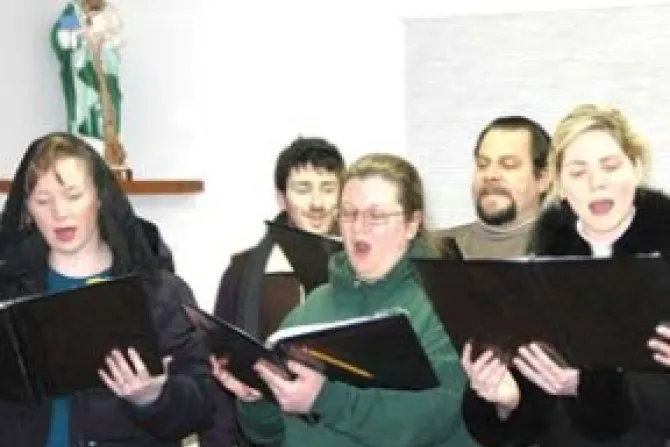Anchorage, Alaska, Feb 7, 2009 / 18:43 pm
On a recent Friday afternoon, amid the bustle of midtown Anchorage traffic, the sounds of Old World liturgical chant — deep baritones mixing with high alto voices — floated from a tiny chapel.
The dozen or so singers who attended the practice session last month come from all walks of life. They are part of a growing chorus of voices in Alaska and across the world who are drawn to the ancient Gregorian chant.
“This music makes me think of the angels and how they sing,”18-year old Patrick Klump mused during a recent choir practice. “I love to sing, and with this I get to give glory to God at the same time,” Klump told the Anchor.
Fellow choir member Tim Main agreed.
“These hymns speak to me about faith,” Main said. “Sometimes it speaks simply, and sometimes profoundly, but either way it is an excellent way for me to pray.”
The group sings every Friday afternoon at Holy Rosary Academy, a K-12 Catholic school that operates independently of the Anchorage Archdiocese school system with permission from Archbishop Roger Schwietz.
Each practice session concludes with the chanting of Vespers. The group also sings for the Dominican rite Latin Mass at Holy Family Cathedral on the first Saturday of each month and occasionally for Masses at Blessed Sacrament Monastery in South Anchorage.
Encountering tradition
(Story continues below)
The newly formed choir is the realized dream of several local Catholics who sought for years to establish a Gregorian chant choir.
Originally a small group of staff and students from Holy Rosary Academy, the choir has since grown to include Catholics from a number of parishes in Anchorage.
The chanters got their opportunity to sing and perform publicly this past fall at the first annual Alaska Catholic Family Conference in Anchorage.
“From there, that’s where we decided that we wanted to get more active,” Mains said. “It got our feet on the ground and got us started.”
Choir member Angela Heaphy, a parishioner at St. Patrick Church, said she joined the group not only because of the singing, but also because it provides an opportunity to learn more about the rich traditions of the Catholic Church.
“It’s great to learn about the history of the church’s music,” she said. “I love the spiritual dimension and the camaraderie of praying in community.”
Preserving the sacred
According to Dr. Stan Grove, a choir member and teacher at Holy Rosary Academy, the roots behind Gregorian chant reach far into history, even before Christ’s birth.
“It’s believed that its organic development came from synagogue chant,” he explained. “People of the Jewish faith would gather and sing the psalms in prayer.”
He added that many church historians believe the first Christian community most likely sang a form of this synagogue prayer.
Gregorian chant rose to prominence in the Catholic Church during the early Middle Ages, around the 6th and 7th centuries and has since reverberated from the inside of monastery and cathedral walls across the world.
Tradition holds that St. Gregory the Great compiled many of the chants that are a part of the Mass today.
Although chant has always had official support from the church, its usage waned in the years following Vatican II (1962-65), when the Roman rite Catholic Mass was opened up to non-Latin languages.
Growing chorus
More recently, there are signs that chant is finding its place again. In 2007, Pope Benedict XVI allowed for wider celebration of the pre-Vatican II Latin Mass, which has created a natural setting for Gregorian chant choirs to flourish.
In Anchorage, the introduction of the Dominican rite Latin Mass has also provided a liturgical context for the new Gregorian chanters.
Grove speaks about the importance of preserving this sacred music and points to church teaching on the matter, including writings from Cardinal Joseph Ratzinger, before he became Pope Benedict XVI in 2005.
“I would be in favor of a new openness toward the use of Latin,” wrote Cardinal Ratzinger in his book “God and the World,” which was published in 2002.
Cardinal Ratzinger continued: “If even in the great liturgical celebrations in Rome, no one can sing the Kyrie or the Sanctus any more, no one knows what Gloria means, then a cultural loss has become a loss of what we share in common.”
As pontiff, Pope Benedict XVI has continued to encourage a renewal of sacred music throughout the world.
It is a cause that U.S. bishops also addressed in a document called “Sing to the Lord.” The document states that Gregorian chant “should be given pride of place in liturgical services.”
The Anchorage chanters believe their choir is one avenue for local Catholics to realize the universal church’s desire to rekindle Gregorian chant.
For Heaphy, chanting has benefits that extend far beyond the choir loft. “It’s great to have the music of the church stuck in my head,” she said. “Often times I find myself humming at home in the kitchen. I get far more out of it than I can contribute.”
Printed with permission from the Catholic Anchor, newspaper from the Diocese of Anchorage, Alaska.


